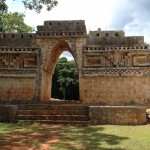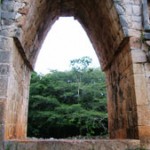Projet de sculpture monumentale
-

-
Labna. Ruta Puuc. Site préhispanique yucatèque. Mexique.
-

-
Labna. Ruta Puuc. Site préhispanique yucatèque. Mexique.
-

-
Mural. Esquisse à l’échelle grandeur du projet de sculpture issu de l’arc architectural du site préhispanique yucatèque Labna.
-

-
« Labna » (2005), in exposition « Traversées », Centre d’art de Mérida. Yucatan
L'exposition de Jean-Charles Pigeau au
Centre d'Art de Mérida réunit sculptures, dessins, photographies, sténopéphotographies et installations réalisées à partir de ses différents séjours au Mexique. Quelques-unes de ces œuvres ont été présentées à la
Galeria de arte contemporaneo de Puebla (2003) et au
Museo de Querétaro (2000), d'autres sont issues de ses résidences artistiques au Yucatan.
Jean-Charles Pigeau, artiste/professeur, invité à deux occasions par l'
Instituto de Cultura de Yucatan (2004-2005), a dirigé un atelier pour le diplôme d'Arts Visuels et la licence d'École supérieure des Beaux-Arts de Mérida (Yucatan). L'artiste a développé un important travail de sténopéphotographies sur la thématique des Ceibas (arbres sacrés) et du vent confrontés aux Cénotes (puits naturels d'eau à ciel ouvert et/ou fermés).
D'autres projets de sculptures ont surgi de l'espace urbain, de site archéologique, de la végétation et du paysage yucatèque.
Pigeau est un artiste voyageur traversant tant les espaces que les cultures et en particulier le monde préhispanique mexicain. Pigeau travaille avec les éléments : vent, terre, eau et feu, et les révèle à travers différents médiums en utilisant des matériaux comme le verre, l'acier, le bronze, l'aluminium, céramique, plâtre, terre crue. Ses œuvres établissent un dialogue avec les espaces sacrés des sites préhispaniques, les constructions monumentales, le paysage, la mythologie et l'histoire.
Dans une recherche infatigable de nouveaux espaces pour ses installations éphémères, Pigeau est intervenu sur le
Lac de Sayula (Jalisco) avec « Suite pour Ciel Seul » en 1992, puis avec « Les Conques » qu'il dépose sur le site gallo-romain de
Vaison-la-Romaine (France 1994), sur le site archéologique de
Xochitécatl (1998) et enfin face au Centre Tjibaou en
Nouvelle-Calédonie (2003). Il réalise des « Captures de vent » sténopéphotographies, avec édition d'un livre « La dialectique du vent », Actes Sud 2003.
Offrandes est un ensemble de sculptures en terre crue déposé face au volcan
Popocatépetl en 1999. L'exposition au
Musée de Querétaro était accompagnée d'une installation éphémère sur le site archéologique «El Cerrito». L'exposition de
Puebla résulte d'une réflexion sur le lieu d'exposition – une ancienne fabrique de toile- et du Popocatépetl, dominant la ville de Puebla
« À lui seul, le volcan réunit la notion Art/Nature/Sciences/Histoire/Mythologie, révélant la relation profonde et immémoriale de l'homme avec la nature » déclare JCP.
Au
Yucatan, l'artiste a eu l'opportunité de partager avec artistes et étudiants ses expériences accumulées au Mexique depuis de nombreuses années, avec une approche toute particulière de l'art préhispanique qui a été une source d'inspiration pour beaucoup d'artistes du 20éme siècle.
Pigeau a pu observer l'arbre magique et emblématique de la culture maya, le ceiba, dans sa dimension sculpturale, ainsi que les cénotes, les comparant à des « cameras obscuras » naturelles.
On découvre le projet de sculpture monumentale intitulé « Labna »2005, sculpture de plâtre, issue d'informations captées sur le site archéologique de Labna en 2003, converties en une sculpture contemporaine mêlant les notions Nature/Sculpture/Architecture/Histoire.
L'exposition «
Traversées » au
Centre d'arts visuels de Mérida permet de découvrir une nouvelle interprétation de notre environnement et patrimoine à travers les propositions et réflexions esthétiques de Jean-Charles Pigeau.
Alfredo Cruz Ramirez
TRAVERSES EXHIBITION
Works by Jean Charles Pigeau
CENTRO DE ARTES VISUALES, Mérida, Yucatan, Mexico
2nd September - 2nd October 2005
Jean Charles Pigeau was born in Pithiviers (France) in 1955. A graduate of the prestigious Parisian art schools: Ecole Boulle and ENSB-A, he is currently a teacher at ESAH, Le Havre School of Art. He participated in the exhibition “The Myth of Two Volcanoes” in 2005 at Mexico City’s Palazzio de Bellas Artes. In November 2005 he had a personal exhibition at the Art of the Century Gallery in New York.
Jean Charles Pigeau’s exhibition in the Mérida Art Centre brought together sculptures, drawings, photographs, pinhole camera pictures and installations resulting from his various trips to Mexico. Some of these works were shown at the Galeria de Arte Contemporaneo in Puebla in 2003 and at the Museo de Querétaro in 2000; others were from his periods as artist in residence in Yucatan.
As artist and teacher, Jean Charles Pigeau was invited twice in 2004 and 2005 by the Yucatan Cultural Institute to hold a workshop at the Mérida Art School for the Visual Arts diploma and the degree course. The artist has built up an important work of pinhole camera photographs on themes such as the ceibas (sacred Mayan trees) and the wind, along with the cénotes (natural water wells).
Other sculpture projects have developed from the urban environment, archaeological sites, vegetation and landscape of Yucatan.
Pigeau is an artist whose travels have led him into a deep exploration of places and cultures, and in particular the Mexican pre-Hispanic world. He deals with the natural elements: wind, earth, water and fire, and reveals them through different mediums using materials such as glass, steel, bronze, aluminium, ceramic, plaster and raw clay. His works engage a dialogue with the sacred areas of pre-Hispanic sites, monumental constructions, landscape, mythology and history.
In a tireless search for new settings for his ephemeral installations, Pigeau has used places as varied as Sayula Lake, Jalisco, Mexico for his “Suite for the Lonely Sky” in 1992, then the Gallo roman site of Vaison-la-Romaine, France for “Conch Shells” in 1994, the archaeological site of Xochitécatl, Mexico in 1998 and the Tjibaou Centre, New Caledonia in 2003. He made pinhole camera photographs, “Wind Captures” with the publication of a book, “Wind Dialectic,” (“La dialectique du vent,”Actes Sud) in 2003.
“Offerings” is a group of sculptures in unbaked clay placed opposite the Popocatépetl volcano in 1999. The exhibition in the Querétaro Museum was accompanied by an ephemeral installation on the “El Cerrito” archaeological site. The Puebla exhibition was the result of a reflection about the exhibition place – an old textile factory – and of the Popocatépetl volcano, overlooking the city of Puebla.
In the words of Jean Charles Pigeau, “The volcano in itself encapsulates the notion Art/Nature/Sciences/History/Mythology, revealing the profound and age-old relation of man with nature.”
In Yucatan, Pigeau had the opportunity to share with fellow artists and students his experiences acquired over the years in Mexico, and his own specific approach to pre-Hispanic art which has been a source of inspiration for many 20
th century artists.
Pigeau was able to observe the ceiba, the magic and emblematic tree of the Maya culture, in its sculptural dimension, as well as the cénotes, comparing them to natural “camera obscura.”
The “Traverses” exhibition at the Mérida Visual Arts Centre was the occasion to discover the monumental sculpture project entitled, “Labna” a plaster sculpture completed in 2005, developed from information gathered on the archaeological site of Labna in 2003 and which had then been converted into a contemporary sculpture mixing the notions Nature/Sculpture/Architecture/History.
“Traverses” offered a new interpretation of the Mexican environment and heritage through the aesthetic propositions and reflections of Jean Charles Pigeau.
Alfredo Cruz Ramirez, director of Yucatan Visual Arts and curator of “Traverses.”




